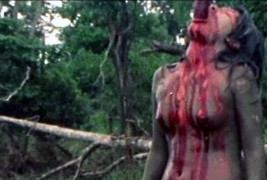
Ravenous Monster’s retrospective series of sick and twisted cinema continues….
“Cannibal Holocaust” is a grimy, twisted little classic that’s greater than the sum of its parts. These are parts that run the gamut of taste and ethical virtue, mind you. Porn stars, authentic animal butchery, real-deal Amazon tribesmen, depictions of sexual violence, cannibalism, and rape. Top it off with a graphic forced abortion and you have the makings of a screen gem, right? Well, as strange as it may seem, the answer is yes.
“Cannibal Holocaust” was unleashed upon the world in 1980. Directed by Ruggero Deodato and written by Gianfranco Clerici, the film is representative of the over the top Italian horror and exploitation output of that era. The premise of “Cannibal Holocaust” is the stuff Exploitation eats for breakfast. The film stars porn veteran Robert Kerman as Harold Monroe, a New York anthropologist who agrees to lead a documentary expedition deep into the Amazon Rainforest in search of another documentary crew that’s gone missing. Aided by his guide Chaco, Monroe and his crew eventually find themselves living among a tribe in the remote reaches of South America.
Through his interactions with the natives, Monroe learns that the missing crew had caused the tribe a great deal of commotion and fear. Monroe slowly, but surely assuages the native’s mistrust toward him and his crew, culminating in classic exploitation fashion when Monroe bathes nude with the tribe’s females, thereby gaining access to the proof of the missing crew’s whereabouts. Nothing says “trust me” like exposing your penis to a group of strange women. But apparently in the Amazon, this is an easy way to break the ice as this technique is successfully whipped out on more than one occasion. The tribal women take Monroe to a shrine made of the missing crew’s bones. Here Monroe finds the crew’s film canisters and eventually procures them from the tribe.
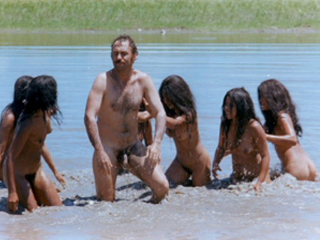
In New York, a production company wants Monroe to host the broadcast of a documentary made from the missing crew’s recovered footage. Monroe decides to review the raw footage to decide how to approach the documentary. Disgusted by what he sees, Monroe shows the footage to the television executives to bolster his case against doing the documentary. This screening comprises the remainder of “Cannibal Holocaust” as we essentially watch along with Monroe. It’s within this footage where most of the abhorrent and infamous elements of “Cannibal Holocaust” are found.
The missing crew, lead by Alan Yates and including Jack Anders, Mark Tomaso, and Faye Daniels begin their trek through the Amazon by finding a tribesman belonging to the village they’re trying to locate. They shoot him in the leg to slow him down, and then follow him home. Upon arriving in the village, they force most of the tribe into a hut and set it afire. Following a litany of egregious and disgusting actions, the coup de gras occurs when the men of the crew gang rape a young tribal woman, which inevitably leads to their demise, a brutal and macabre affair which they manage to film before the last of them succumbs to the tribe’s cannibalistic retribution.
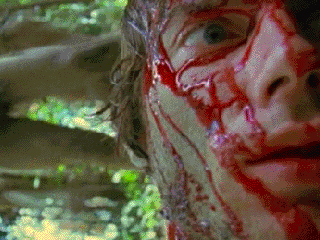
Before I heap praise upon this nasty bugger of a movie, praise that’s completely justified by the film’s rapid pace, tight story, and compelling action, let’s discuss the more egregious and unfortunate elements of “Cannibal Holocaust”.
I have an infatuation with movies in which our heroes are eviscerated by blade-wielding maniacs, devoured by monsters, and occasionally possessed by demons, but I’m actually a softy at heart, especially when it pertains to animals. I’m a horror movie fan mainly because I enjoy the art of storytelling, “art” being the key, as it relates to “artifice” – cleverly deceptive, thought-provoking works, i.e., stories.
Unfortunately, “Cannibal Holocaust” contains scenes in which a total of six animals are killed – really killed – in character by the actors. Deodado argued that by depicting his characters authentically killing, butchering, and consuming animals (and in one case abusing an animal to help establish the abuser as antagonistic and deserving his inevitable demise), the audience would more easily buy the depictions of human dismemberment and cannibalizing that follows. He was correct. But it begs the question, where do we draw the line? Would a zero tolerance approach to animal cruelty create a slippery slope on which filmmakers slide toward a larger philosophical debate over the potential collateral damage caused by the filmmaking enterprise? Absolutely not. In films we use artifice to depict human characters’ deaths. The reason for this is obvious and it should extend to animals as well.
I understand the logical justification behind Deodado’s decision to film authentic animal abuse and butchery, but it doesn’t hold up to the moral argument against it. The harming and killing of animals to help tell a story, to create an illusion for the mere purpose of entertainment can’t be rationalized. So, needless to say, the ends don’t justify the means.
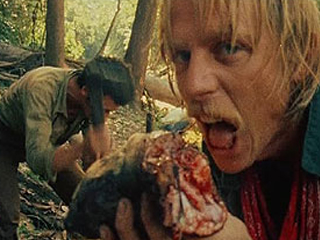
The other issue I have with “Cannibal Holocaust” is the way it uses an authentic tribe to exploit itself by propagating real stereotypes in a fictional work – those Amazonian heathens running around eating those advanced and proper folks. It’s a multi-layered exploitation in that it’s an exploitation film about an exploitation film that’s sort of supporting cultural relativism and railing against ethnocentrism. It does so by halfheartedly making a statement about the evils of modern culture versus the innocence of primitive culture. It’s really just pure sensationalism couched in flimsy and insincere moralizing. And in the context of the film, it doesn’t matter because the movie delivers entertainment in a big way, with or without tacking on an insincere “lesson” as an apology for the film’s existence. I believe that anything goes in fiction, but I would feel a lot better about depicting the tribe eating all those white folks if the tribe was a fictional one. I know, I know. You came here expecting to read about an infamous exploitation film, not a lecture on ethics from high atop a cyber-soapbox. But there’s more to talk about here than just blood and boobs…and weiners.
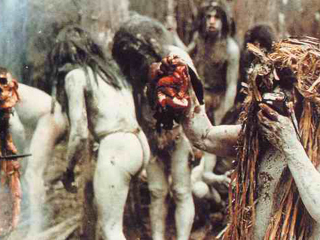
Despite these questionable film making tactics, the influence and effectiveness of “Cannibal Holocaust” cannot be argued against.
“Cannibal Holocaust” is the progenitor of two commonplace horror film conventions the origins of which are usually attributed to another low budget classic that burst onto the scene nineteen years later. That movie is “The Blair Witch Project”, the sleeper hit that came out of nowhere in 1999 to deceive the ridiculously gullible among us into questioning whether or not what they were watching was in fact real. This was largely due to its total devotion to the “found footage” device, whereby the film is shot entirely with a camera wielded by one or more of its characters. Several movies have capitalized on the novel and successful use of the technique since “Blair Witch” including “Cloverfield”, “[REC]”, “Quarantine”, “Diary of the Dead”, and more.
The other cause of the “Blair Witch” phenomenon was its marketing strategy. The filmmakers took advantage of the still-burgeoning internet and constructed an interactive website which contained supplemental information on the legend of the Blair Witch as well as news reports, interviews, etc. By using this meta-fictional marketing technique in which elements of the story are pulled into the real world, the filmmakers were able to generate incredible buzz via word-of-mouth by blurring the line between fiction and reality and again duping the gullible into a ruse, while entertaining those of us who have both feet firmly planted on planet earth.
“The Blair Witch Project” deserves credit for popularizing these unique techniques, but the fact remains that “Cannibal Holocaust” employed them first. While the “found footage” device isn’t as immersive in “Cannibal Holocaust” as it is in the movies that came in the wake of “Blair Witch”, Cannibal’s narrative is structured around this device and a large portion of the movie is represented via the missing documentarians’ recovered footage.
Obviously, the Internet wasn’t around in 1980, but “Cannibal Holocaust” was also creatively marketed. The cast signed contracts with Deodado and the film’s producers which stipulated that they weren’t allowed to appear in any media for a year following the release of the film. This was done to propagate the movie’s authenticity. Unfortunately, the most gullible among us when “Cannibal Holocaust” was released also happened to be among the most powerful, as Deodado was arrested for making a snuff film. He was easily able to expose his ruse by asking his cast to break their contracts, but the film’s inauspicious start was a harbinger of more controversy to come.
Although Deodado was officially declared innocent of murder, the Italian courts banned “Cannibal Holocaust” – a ban that Deodado spent the subsequent few years fighting to overturn. While this battle was waged, the film made its way around the world. It showed up on the infamous “Video Nasties” list compiled by the U.K.’s Department of Public Prosecutions. The list was comprised of movies that were released direct-to-video to circumvent the British Board of Film Classification. In 1984 “Cannibal Holocaust” was banned in several countries including Norway, New Zealand, Australia, and several others. In subsequent years some of these bans were lifted, but only after heavily censored versions of the movie were presented to the powers that be. In its original presentation, “Cannibal Holocaust” is still banned outright in some countries and it’s universally considered one of the most controversial films ever made.
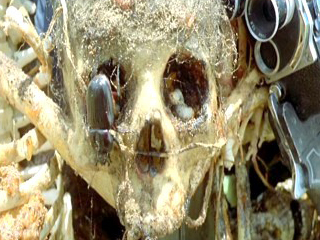
Once we get beyond all the elements external to the film, “Cannibal Holocaust” is not difficult to critique on its cinematic merits. It’s a good movie. Its innovative film-within-a-film structure is compelling in its own right, but the way this device affects other facets of the production is beneficial to the film’s overall quality. For example, the cast is comprised of people who by their own admissions will never be known for their great dramatic prowess. However, by shooting largely on location using the cinéma vérité style, it wasn’t much of a stretch for the cast to convey what their characters are experiencing under duress as they’re surrounded by miles of rainforest and culture shock.
The film also boasts high quality, realistic special FX by Aldo Gasparri. These are typified by the iconic set piece of the impaled tribal woman, which was rumored to have been authentic upon the film’s release. The gore isn’t over-the-top and shoved down our throats (shoved up our throats would be more accurate, but I digress) in a way that calls attention to itself. Rather, it’s contextualized by the events facing our characters and believably portrayed as the result of the violence inflicted and/or filmed by our “film crew”.
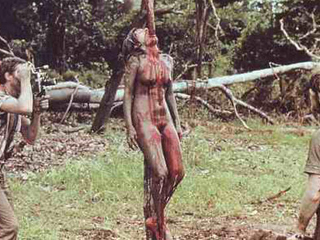
The rapid pace of “Cannibal Holocaust” is a huge asset. Editor, Vincenzo Tomassi wastes not a frame. It’s one of the reasons the film holds up so well now, in the era of the abbreviated attention span. Once the film begins, the momentum gradually increases and never ebbs until after the movie’s gluttonous and glorious climatic orgy of vengeful violence. It’s like a thrill ride past a myriad of accident scenes, all of which one can’t help but stare at, eyes wide and mouth agape.
All these elements are neatly tied together by composer, Riz Ortolani’s brilliant and dynamic music. The score combines the musical conventions of the era with flavors that run the gamut in style and tempo. The results are orchestral passages, electro vibes, and synthesized sound-cacophonies, giving us slow-and-melancholy to fast-and-chaotic.
The film’s legacy is firmly cemented and well respected among its peers. “Cannibal Holocaust” is a benchmark genre movie. It’s an incredibly effective and well-executed film that has inspired subsequent filmmakers and has informed successful films in its wake. It’s a movie for which only the shameless proclaim an affinity outright, while the rest of us admire it from afar if we’re brave enough to experience it at all. I guess I have no shame. If you’ve seen this horrid nightmare of a “documentary” gone wrong, give it another look and if you haven’t yet braved this macabre hour and a half, then do so. You won’t regret it…entirely.
7 thoughts on “Cannibal Holocaust: Welcome to the Jungle”
Comments are closed.



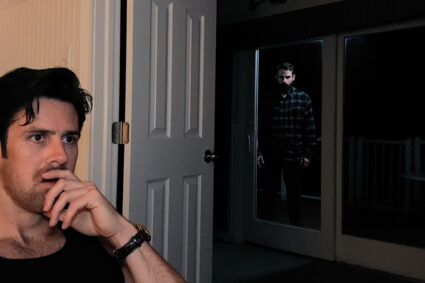
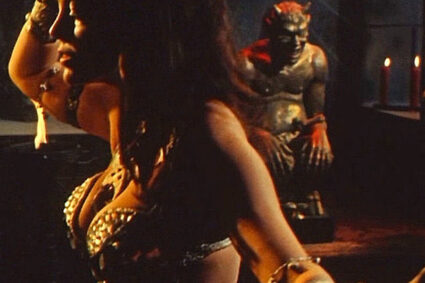










I just can’t abide films with real animal torture so I’ve never seen “Cannibal Holocaust” and probably never will. This is a terrific analysis of the film, though, because it’s more than just a look at how “gross” it is. You can’t have a really intelligent discussion of the movie without bringing up these points and the article does this in a way that doesn’t ignore the repugnant morals while still finding strength in the film.
Thanks for the kind words, Doc-
I’ve always had a hard time with those elements of this movie. I don’t even feel comfortable watching lions take down a zebra on National Geographic, nevermind watching animals die a meaningless, arbitrary death. Granted, the animal killing incidences are clearly things the filmmakers saw the indigenous people doing as most of it has to do with hunting and eating. But it’s also true that a retake necessitated the killing of one animal in order to “get the shot” which means that it wasn’t just a necessary rain forest survival technique that Deodado decided to shoot and include in his film, but rather something that was done specifically for the film. I can’t justify or defend that in any way. The movie’s one hell of a ride, nonetheless.
Well done, Jason. Well thought out and professionally presented.
Incredibly well written and insightful article Jason. So much so that it prompted me to watch this movie. Given the ‘history’ behind it, I was surprised to find it available on Netflix DVD. The disc had the original, unedited version as well as an animal-cruelty-free version. Having watched the former I have to admit I didn’t think the animal scenes would effect me much having field-dressed a fair number of animals myself as a hunter & angler. Admittedly, I felt more squeamish than I would have imagined, perhaps due to the fact that I knew at least one of the scenes was a reshoot (knowledge gained from this article). Personally, I have no problem wtih the butchering animals for survival. But doing so for the sake of “getting it right” does make my stomach turn however.
Anyhow, thank you for bringing this absolutely obscure piece of film history to our attention. The movie itself is rather amazing given it was made in 1980 (concept, spfx, etc.) This article of review… even more so.
Thanks Bowie, and thanks Ryan.
Ryan, I’m glad you decided to get a hold of the movie and give it a shot. That, in part, is what we’re trying to accomplish with Ravenous Monster. There are many examples of outstanding horror spanning different media, but much of it is obscure for a variety of reasons including age and budget. We try to expose what’s good and criticize what’s bad.
Thanks for sharing your reaction and your thoughts on it. I absolutely understand the justification for hunting – the animal as a sustaining resource. I wouldn’t and probably couldn’t hunt, but I understand its cultural and practical roots. However, the arbitrary killing of animals to help tell this story is abhorent and it flies in the face of the respect for the animal as a valuable resource that most hunters exhibit. So, I would guess your unexpectedly squeamish reaction is a testament to your level of responsibility as a hunter, which reflects well on you, good sir!
Thanks again.
It takes lot of courage to be a part of such kind of a movie.. hats-off to you man…
Shocking photos. I think that these savages civilization will never come!